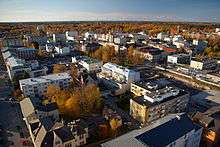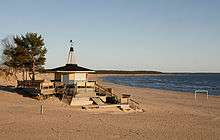West Coast (Finland)
The West Coast of Finland is a geographically flat region bordering the Gulf of Bothnia. Being the westernmost part of Finland, this is where western influences such as Christianity first arrived in Finland. As a result of this, here you can find some of Finland's oldest cities and towns as well as a sizable part of the country's Swedish-speaking minority. This article comprises the pre-1997 Turku and Pori as well as Vaasa provinces.
Regions

| Central Ostrobothnia Central Ostrobothnia is both geographically and population-wise one relatively small. Most things of interest can be found in the region's largest city Kokkola. |
| Ostrobothnia The region of Ostrobothnia has a large Swedish-speaking population and a quite interesting archipelago — the Kvarken Archipelago — which is slowly rising up from the sea due to post-glacial rebound. |
| Southern Ostrobothnia This remarkably flat region is home to several music related events and the country's most famous hard alcohol brand, Koskenkorva. |
| Satakunta This region hosts two UNESCO world heritage sites; Rauma's old town and the Sammallahti bronze age burial site. The sand beaches of Yyteri are also quite popular in the summer. |
| Finland Proper The southwesternmost part of Finland is called Finland Proper for historical reasons. The largest city here, Turku, is the oldest city of Finland and hosts a castle and a cathedral that are amongst the oldest in the country. The archipelago that reaches all the way to the Åland islands is another popular destination in the region and especially beautiful in the summer. |
Cities

- 🌍 Turku /Åbo: the former capital city of Finland
- 🌍 Naantali /Nådendal: Moominvalley, the home of the Moomins
- 🌍 Rauma /Raumo, beautifully preserved old town which is on the UNESCO world heritage list
- 🌍 Pori /Björneborg
- 🌍 Vaasa /Vasa
- 🌍 Kokkola /Karleby
- 🌍 Seinäjoki
- Pietarsaari/Jakobstad
- Kristiinankaupunki/Kristinestad
Other destinations
Understand
The West Coast is a region with long-standing agricultural traditions. The southwest is the "breadbasket of Finland". Vast expanses of flat land with cultivated fields characterize the Ostrobothnian (Finnish: Pohjanmaa, Swedish: Österbotten) region, in obvious contrast to the heavily forested inland Finland. Coastal traditions, fishing and boating are also a part of the tourism scene in the region. As an exception, the hinterlands of Satakunta between Pori and Tampere are densely forested, sparsely populated and can be relatively hard to reach.
In Finnish ethnography, the west coast does not form a unified entity, but is divided between Ostrobothnia and the Southwest, which have different dialects. Furthermore, in the inland, there is a small region of Savo dialect speakers (savolaiskiila) in southeastern Ostrobothnia and Häme dialect speakers in eastern Satakunta. Owing to old traditions of agricultural land ownership, both cultures place a high value on honesty, the Protestant work ethic and property ownership. Distinctively, as compared to the rest of Finland, there are many small and medium-sized enterprises that result in a high level of economic development. Religious awakening or revival movements with a lay preacher tradition, such as Laestadianism, are particularly popular in the Ostrobothnia region.
A second major feature of the region are the Swedish-speakers. Swedish-speakers are often in the majority in the countryside along the coasts, and much of the archipelago is more or less exclusively Swedish-speaking. Cities and towns are bilingual with Finnish as the majority language, with the exception of some small towns in Ostrobothnia like Kristinestad, Jakobstad and Nykarleby, and Pargas in Finland Proper, where Swedish is the majority language.
Talk
The region Ostrobothnia, as well as the southern archipelago (bordering to Åland), has a Swedish speaking majority. Also Turku is bilingual, with the only Swedish university in Finland.
Get in

After Helsinki, cities in Western Finland have the best international connections.
By plane
Domestically, Turku, Pori, Vaasa and Kokkola have flights from Helsinki, though unless you're connecting from an international flights or in an extreme hurry flying from Helsinki doesn't make much sense — even Kokkola is reachable in just four hours by the fastest trains. In addition Turku and Vaasa are served from Stockholm by SAS, moreover AirBaltic and Wizz Air fly to Turku from Riga and Gdansk, respectively. Tampere airport is the Finnish hub for low-cost airline Ryanair (though as of 2016 Ryanair doesn't serve Tampere in the winter) and fairly close and well connected to Satakunta, Southern Ostrobothnia and Finland Proper.
By train
Trains between the three major cities of Turku, Tampere and Helsinki are very frequent. Seinäjoki and Vaasa are also accessible by train.
By bus
Major cities are connected to each other and to Helsinki by frequent buses and most smaller towns have a couple of daily buses to the nearest major city.
By boat
There are four daily ferries from Stockholm to Turku via Åland; Silja Line and Viking Line have one day and one overnight departure each. From Kapellskär near Norrtälje Finnlines sail to Naantali for those with vehicles, and you can also get in with smaller ferries from various islands in the Åland archipelago. Further north Vaasanlaivat's Wasa Express brings passengers from Umeå to Vaasa. This route has a history of economic problems since it lost taxfree rights, but financing now seems to be being secured for at least some years.
The passages over the Sea of Åland and Kvarken (in Gulf of Bothnia) are short enough also for small boats on a fine day. From Åland one can continue through the Archipelago Sea outside Turku.
By car
There are good roads to the main towns of the region.
Get around
The Finnish main north-south train route from Helsinki passes through Seinäjoki, Bennäs near Jakobstad and Kokkola so if you are moving about in these areas, or along the Turku–Tampere railway, consider taking the train. If you want to travel between places along the coast, train isn't the best alternative.
Buses are usually the best form of intercity public transportation. In some of the countryside services are very sparse.
As elsewhere in Finland, driving is the most convenient way to get to remote places. Pay attention to the speed limits on highways — speed cameras are frequent! Unfortunately, national roads in the region, such as national road 8, are usually only simple two-lane highways with a lot of truck traffic and speed limits that change intermittently from 80 to 100.
See

- Turku castle and cathedral.
- The old town of Rauma, an UNESCO World Heritage Site.
- The Bronze Age burial site in Sammallahdenmäki, an UNESCO World Heritage Site.
- Kvarken Archipelago, an UNESCO World Heritage Site.
- Giant kettle Pirunpesä in Jalasjärvi, the deepest earth erosion in Europe.
- The plains of Southern Ostrobothnia.
- Kultaranta, the summer residence of the President of Finland in Naantali.
- Alvar Aalto center, the administrative and cultural center of Seinäjoki, designed by Alvar Aalto in the late 1950s.
Do

- Sail around the archipelago near Turku.
- Go swimming at Yyteri sand beach near Pori.
- Enjoy music at Finland's oldest rock festival Ruisrock in Turku each July.
- Meet the characters from the Moomin stories in the theme park Muumimaailma in Naantali and relax at the Naantali Spa.
- Dance tango at the yearly Tangomarkkinat festival in Seinäjoki.
- Celebrate the ending of the summer cottage season with fireworks in Kokkola.
- Watch a local hockey derby in Rauma or Pori
Eat
The Archipelago Sea is, unsurprisingly, famous for seafood dishes. Also, juice and jam of sea buckthorn (Finnish:tyrni) is generally associated with the West Coast. A fast food speciality from Pori (available elsewhere in the country too) is porilainen — a kind of a "hamburger" made with two slices of white bread, between them a thick slice of sausage and onion dices, pickled cucumber, ketchup and mustard.